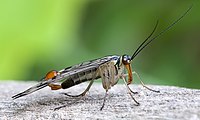
Photo from wikipedia
The aim of this study was to analyse a novel group farrowing system (GH) concerning piglets’ behaviour, skin injuries and body weight gain, to test its animal friendliness. Skin injuries… Click to show full abstract
The aim of this study was to analyse a novel group farrowing system (GH) concerning piglets’ behaviour, skin injuries and body weight gain, to test its animal friendliness. Skin injuries and weight gain were compared to piglets originating from conventional individual housing (IH) before and after weaning. The GH system had five farrowing pens without crates, a common area and an area only available for piglets. In total, 34 litters were studied. Four days after the GH-piglets had left the pens during lactation, the lesion score of piglets in GH was higher than in IH. However, piglets from the GH sustained fewer injuries after mixing at weaning, compared to the piglets from IH and had higher daily weight gains, during the early nursery phase. The common area in GH was intensively used for active behaviour, since standing/walking and playing were observed there, most frequently, whereas lying occurred most frequently inside the pens. Immediately after the piglets had left the pens in the GH, the piglets preferred proximity to the sow, compared to the pens where they were born. The GH system enabled social enrichment, offered increased space for activity and led to fewer skin lesions, after weaning; thus, potentially increasing animal welfare.
Journal Title: Agriculture
Year Published: 2019
Link to full text (if available)
Share on Social Media: Sign Up to like & get
recommendations!